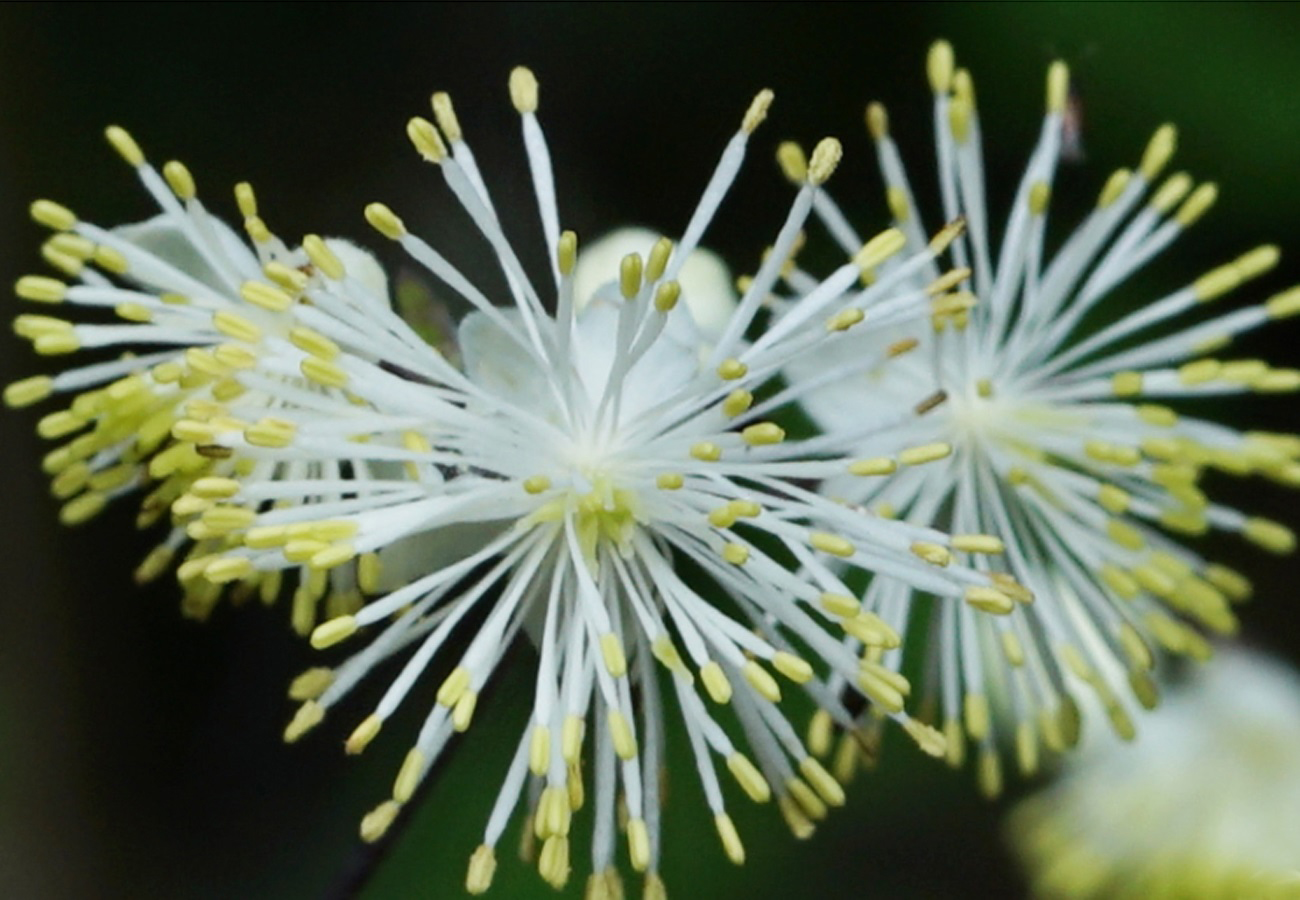Abstract
Based on critical observations on both herbarium specimens (including type material) and living plants in the wild, here we clarify some morphological characters in the Chinese species Thalictrum przewalskii (Ranunculaceae) and demonstrate that T. lasiogynum and T. latistylum, described respectively from China’s Sichuan and Gansu provinces, are conspecific with it. We therefore reduce T. lasiogynum and T. latistylum to the synonymy of T. przewalskii. Thalictrum sect. Platystylus, which was established to accommodate T. latistylum, is reduced to the synonymy under T. sect. Omalophysa. The identity of T. rockii is further confirmed and the distribution in China of T. sparsiflorum, a species most closely similar to T. przewalskii and widely distributed in northeastern Asia and North America, is also determined.
References
<p>Anonymous (1972) Iconographia Cormophytorum Sinicorum, vol. 1. Science Press, Beijing, 1157 pp. <br>Anonymous (1975) Thalictrum L. In: Anonymous (Ed.) Flora Plantarum Herbacerum Chinae Boreali-orientalis, vol. 3. Science Press, Beijing, pp. 201‒218.<br>Anonymous (1976) Thalictrum L. In: Anonymous (Ed.) Flora Hupehensis, vol. 1. Hubei People’s Press, Wuhan, pp. 352‒359.<br>Anonymous (2000) Ranunculaceae. In: Fu, K.T., Fu, J.Q. & Chen, Y.S. (Eds.) Flora Loess-Plateaus Sinicae, vol. 1. Science Press, Beijing, pp. 349‒471.<br>Boivin, B. (1945) Notes on some Chinese and Korean species of Thalictrum. Journal of the Arnold Arboretum 26: 111–118.<br>Ding, B.Z., Wang, S.Y. & Gao, Z.Y. (1981) Thalictrum L. In: Ding, B.Z., Wang, S.Y. & Gao, Z.Y. (Eds.) Flora Henanensis, vol. 1. Henan People’s Publishing House, Zhengzhou, pp. 466‒474.<br>Emura, K.M.H. (1972) Cytotaxonomical studies on the genus Thalictrum in Eurasia with special reference to Japanese species. Journal of the Faculty of Science, the University of Tokyo, sect. 3, Botany 11: 93‒135.<br>Finet, A.E. & Gagnepain, F. (1903) Contributions a la flore de l’Asie orientale d’aprés l’herbier du muséum de Paris. Bulletin de la Société Botanique de France 50: 600–625. https://doi.org/10.1080/00378941.1903.10831058<br>Fischer, F.E.L. & Meyer, C.A. (1835) Index Seminum 1. Animadversiones Botanincea, St. Petersburg, 42 pp.<br>Fu, D.Z. & Zhu, G.H. (2001) Thalictrum Linnaeus. In: Wu, Z.Y., Raven, P.H. & Hong, D.Y. (Eds.) Flora of China, vol. 6. Science Press, Beijing & Missouri Botanical Garden Press, St. Louis, pp. 282–302.<br>Grubov, V.I. (2000) Catalogue of the Type Specimens of Central Asian Vascular Plants in the Herbarium of the V.L. Komarov Botanical Institute (LE). St. Petersburg University Press, St. Petersburg, 235 pp.<br>Handel-Mazzetti, H. (1931) Ranunculaceae. In: Symbolae Sinicae, vol. 7. Julius Springer, Wien, pp. 265–321.<br>He, S.Y. (1986) Thalictrum L. In: He, S.Y (Ed.) Flora Hebeiensis, vol. 1. Heibei Science & Technology Press, Shijiazhuang, pp. 440–447.<br>He, S.Y. (1992) Thalictrum L. In: He, S.Y. & Yin, Z.T. (Eds.) Flora of Beijing, vol. 1. Beijing Publishing House, Beijing, pp. 236–242.<br>Lecoyer, J.C. (1885) Monographie du genre Thalictrum. Bulletin de la Société Royale de Botanique de Belgique 24: 78–324.<br>Li, B.L., Yu, X.Y. & Li, Y.M. (1990) Thalictrum L. In: Liu, T.W. (Ed.) Flora Taiyuanica, vol. 1. Academic Publishing House, Beijing, pp. 314‒323.<br>Linnaeus, C. (1753) Species Plantarum. Laurentii Salvii, Holmiae, 1200 pp.<br>Liu, K.M. (2000) Thalictrum Linn. In: Liu, K.M. (Ed.) Flora of Hunan, vol. 2. Hunan Science & Technology Press, Changsha, pp. 648–657.<br>Ma, D.Z. & Liu, H.L. (1986) Ranunculaceae. In: Ma, D.Z. & Liu, H.L. (Eds.) Flora Ningxiaensis, vol. 1. Ningxia People’s Publishing House, Yinchuan, pp. 163‒199.<br>Ma, D.Z., Liu, H.L. & Hu, F.X. (2007) Ranunculaceae. In: Ma, D.Z., Liu, H.L. & Hu, F.X. (Eds.) Flora Ningxiaensis (2nd ed.), vol. 1. Ningxia People’s Publishing House, Yinchuan, pp. 202‒248.<br>Maximowicz, C.J. (1877) Diagnoses plantarum novarum Asiaticarum. Bulletin de l’Académie Impériale des Sciences de St-Pétersbourg 23: 305‒391. https://doi.org/10.5962/bhl.title.46308<br>Maximowicz, C.J. (1889) Flora Tangutica, vol. 1. Typis Academiae Imperialis Scientiarum Petropolitanae, St. Petersburg, 110 pp. <br>Prantl, K. (1887) Beiträge zur Morphologie und Systematik der Ranunculaceen. Botanische Jahrbücher für Systematik, Pflanzengeschichte und Pflanzengeographie 9: 225–273.<br>Tamura, M. (1995) Thalictrum L. In: Hiepko, P. (Ed.) Die Natürlichen Pflanzenfamilien, Band 17 a IV. Duncker und Humblot, Berlin, pp. 474–494.<br>Wang, W.T. (1980) Notulae de Ranunculaceis sinensibus (IV). Bulletin of Botanical Laboratory of North-Eastern Forestry Institute 8: 15–38.<br>Wang, W.T. (1985) Thalictrum L. In: Wu, C.Y. (Ed.) Flora Xizangica, vol. 2. Science Press, Beijing, pp. 63‒76.<br>Wang, W.T. (2000) Thalictrum L. In: Fu, L.K. & Hong, T. (Eds.) Higher Plants of China, vol. 3. Qingdao Publishing House, Qingdao, pp. 459‒481.<br>Wang, W.T. (2017a) Five new species of Thalictrum (Ranunculaceae) from China. Guihaia 37: 407–416.<br>Wang, W.T. (2017b) Six new species of Thalictrum (Ranunculaceae) from China. Guihaia 37: 675–684.<br>Wang, W.T. (2018) Thalictrum (Ranunculaceae) in China. Peking University Press, Beijing, 376 pp.<br>Wang, W.T. & Liu, B. (2016) Ranunculaceae. In: Wang, W.T. & Liu, B. (Eds.) Higher Plants of China in Colour, vol. 3. Science Press, Beijing, pp. 332−451.<br>Wang, W.T. & Wang, S.H. (1974) Thalictrum Linn. In: Anonymous (Ed.) Flora Tsinlingensis, vol. 1 (2). Science Press, Beijing, pp. 238−247.<br>Wang, W.T. & Wang, S.H. (1979) Thalictrum L. In: Anonymous (Ed.) Flora Reipublicae Popularis Sinicae, vol. 27. Science Press, Beijing, pp. 502–592.<br>Xie, L., Wang, Z.T., Liu, Q., Li, S.M., Li, Y.S., Song, R.K., Zhao, S.M., Han, L.T., Wang, W., Yu, L., Qian, J.S., Yang, X.W., Zhang, Y.T., Qiao, X., Yang, X.B., Cong, X., Ma, T., Dong, S.Z., Wang, A.N., He, Z.Y. & Pei, J. (2016) Thalictrum L. In: Wei, F.N., Wang, Z.T., Zhang, W.S., Pei, J. & Yang, X.W. (Eds.) Medical Flora of China, vol. 3. Peking University Medical Press, Beijing, pp. 231‒287.<br>Yu, X.Y., Li, B.L. & Liu, Y.M. (1992) Thalictrum L. In: Liu, T.W. (Ed.) Flora Shanxiensis, vol. 1. China Science & Technology Press, Beijing, pp. 592−611.<br>Zhao, Y.Z. (1990) Thalictrum L. In: Ma, Y.C. (Ed.) Flora Intramongolica, vol. 2. Inner Mongolia People’s Publishing House, Huhhot, pp. 448‒463.<br>Zhou, L.H. (1997) Ranunculaceae. In: Zhou, L.H. & Huang, R.F. (Eds.) Flora Qinghaica (“Qinghaiica”), vol. 1. Qinghai People’s Publishing House, Xining, pp. 288‒370.</p>


